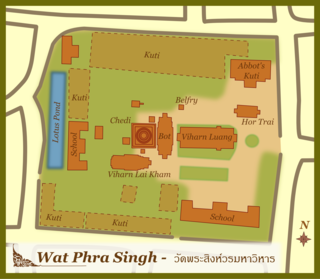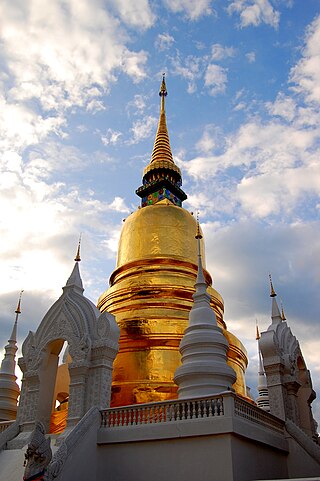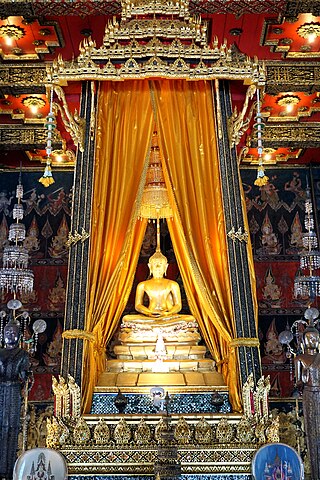
The Emerald Buddha is an image of the meditating Gautama Buddha seated in a meditative posture, made of a semi-precious green stone, clothed in gold. and about 66 centimetres (26 in) tall. The image is considered the sacred palladium of Thailand. It is housed in the Temple of the Emerald Buddha on the grounds of the Grand Palace in Bangkok.

Chiang Mai is the largest city in northern Thailand, the capital of Chiang Mai province and the second largest city in Thailand. It is 700 km (435 mi) north of Bangkok in a mountainous region called the Thai highlands and has a population of 1.2 million people as of 2022, which is more than 66 percent of the total population of Chiang Mai province.

Phayao is one of Thailand's seventy-seven provinces (changwat), and lies in upper northern Thailand. Neighboring provinces are Nan, Phrae, Lampang, and Chiang Rai. To the northeast it borders Xaignabouli in Laos.

Wat Chedi Liam, formerly known as Wat Ku Kham, is one of the wats in the ancient Thai city of Wiang Kum Kam, now part of present-day Chiang Mai.

Wat Phra Kaew is a third-common-class royal temple situated in the area of 10,640 square metres on Trairat road, Wiang sub-district, Muang Chiang Rai in Chiang Rai City, Thailand. The King of Thailand upgraded the temple to the royal temple on May 31, 1978. The temple gains historical importance as the place where the Emerald Buddha was found. It is also one of the main centres of Buddhist education and the Sangha's administration in northern Thailand.

Wiang Kum Kam is an historic settlement and archaeological site along the Ping River, which was built by King Mangrai the Great as his capital before he moved it to Chiang Mai. It was flooded and abandoned more than 700 years ago; that move became more understandable in 2005, when the ancient city was flooded three separate times as the river overflowed its banks in that area of Chiang Mai.

A wat is a type of Buddhist and Hindu temple in Cambodia, Laos, East Shan State, Yunnan, the Southern Province of Sri Lanka, and Thailand.

Wat Phra Singh is a Buddhist temple in Chiang Mai, northern Thailand. King Ananda Mahidol, bestowed upon it the status of Royal temple of the first grade in 1935.

Wat Suan Dok, also known as Wat Buppharam is a Buddhist temple (Wat) in Chiang Mai, northern Thailand. It is a Royal Temple of the Third Class. The temple is on Suthep Road, approximately one kilometre west of Suan Dok gate at the west side of the moat.

Wat Pa Sak is a wat in Chiang Saen District, Chiang Rai Province, Thailand. Located just outside the city's old walls, the temple derives its name from the 300 teaks planted on the site around the time of its foundation. Wat Pa Sak's origins date back to the 13th or 14th centuries.

Wat Ku Tao is a Buddhist temple in Chiang Mai, Thailand. The temple was built in 1613 to enshrine the remains of Nawrahta Minsaw, the first Burmese ruler of Lan Na. The temple is known for its distinctive chedi, which was built in the Yunnanese style, arranged in a series of five diminishing spheres that represent the five historical and future Buddhas. The temple presently caters to Chiang Mai's Shan community.

Wat Saen Fang is a Buddhist temple in Chiang Mai, Thailand. The temple was founded in the 1500s, but all extant structures date to the 1800s or later. The viharn of Wat Saen Fang previously served as the royal residence of Kawirolot in the 1860s, and was converted into a viharn by his successor, Inthawichayanon in 1878. The temple is also noted for its Burmese-style chedi, which is gilded with glass mosaic. The ubosot, which is topped with kinnara, is a fusion of Burmese and Lan Na styles.

The Phra Phuttha Sihing is a highly revered image of the Gautama Buddha in Bangkok, Thailand, second in importance only after the Emerald Buddha. The image is currently housed at the Phutthaisawan Hall, now the Bangkok National Museum. The image was brought to Bangkok from Wat Phra Singh, Chiang Mai in 1795 by Viceroy Maha Sura Singhanat, the brother of King Rama I.

Wat Mahawan is a Buddhist temple in Chiang Mai, Thailand. It is located on the eastern periphery of the old city of Chiang Mai in Thaphae Road.

Wat Phan Tao is a Buddhist temple in Chiang Mai, northern Thailand. It is situated on Prapokklao Road, Mueang Chiang Mai district, in the centre of the old city.

Wat Prasat is a Buddhist temple in Chiang Mai, northern Thailand. It is situated on Inthawarorot Road in the old city.

Wat Phuak Hong is a Buddhist temple in Chiang Mai, northern Thailand. It is situated on Samlarn Road in the old city.

Wat Umong Maha Thera Chan is a Buddhist temple in Chiang Mai, northern Thailand. It is situated on Ratchapakhinai Road in the centre of the old city.

Wat Rampoeng, also known as Wat Taoptharam, is a Buddhist temple in Chiang Mai, northern Thailand. It is situated in the area of Suthep subdistrict, Mueang Chiang Mai, on the outskirts of the city. The temple is well known for its meditation centre.



















